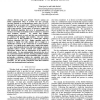INFOCOM
2006
IEEE
14 years 6 months ago
2006
IEEE
— Large-scale peer-to-peer systems span a wide range of Internet locations. Such diversity can be leveraged to build overlay “detours” to circumvent periods of poor performan...
INFOCOM
2006
IEEE
14 years 6 months ago
2006
IEEE
—We consider a set of flows passing through a set of servers. The injection rate into each flow is governed by a flow control that increases the injection rate when all the se...
INFOCOM
2006
IEEE
14 years 6 months ago
2006
IEEE
— Emerging network applications tend to be built over heterogeneous network resources spanning multiple management domains. Many such applications have dynamic demands for dedica...
INFOCOM
2006
IEEE
14 years 6 months ago
2006
IEEE
Abstract— The topological structure of the Internet infrastructure is an important and interesting subject that attracted significant research attention in the last few years. A...
INFOCOM
2006
IEEE
14 years 6 months ago
2006
IEEE
— In this paper, we seek to understand the intrinsic reasons for the well-known phenomenon of heavy-tailed degree in the Internet AS graph and argue that in contrast to tradition...
INFOCOM
2006
IEEE
14 years 6 months ago
2006
IEEE
— Internet traffic is bursty and network servers are often overloaded with surprising events or abnormal client request patterns. This paper studies scheduling algorithms for in...
INFOCOM
2006
IEEE
14 years 6 months ago
2006
IEEE
—Wireless local area network (WLAN) systems are widely implemented today to provide hot spot coverage. Operated typically in an infrastructure mode, each WLAN is managed by an ac...
INFOCOM
2006
IEEE
14 years 6 months ago
2006
IEEE
—In this paper, we propose a link-directionality-based dual channel MAC protocol in an attempt to double the capacities of networks using the single-channel 802.11 protocol. Simu...
INFOCOM
2006
IEEE
14 years 6 months ago
2006
IEEE
— We consider feed-forward packet switched networks with fixed routing and random congestion losses. Users of the network are assumed to be greedy in the sense that each user in...
INFOCOM
2006
IEEE
14 years 6 months ago
2006
IEEE
— While structured P2P systems (such as DHTs) are often regarded as an improvement over unstructured P2P systems (such as super-peer networks) in terms of routing efficiency, it...




